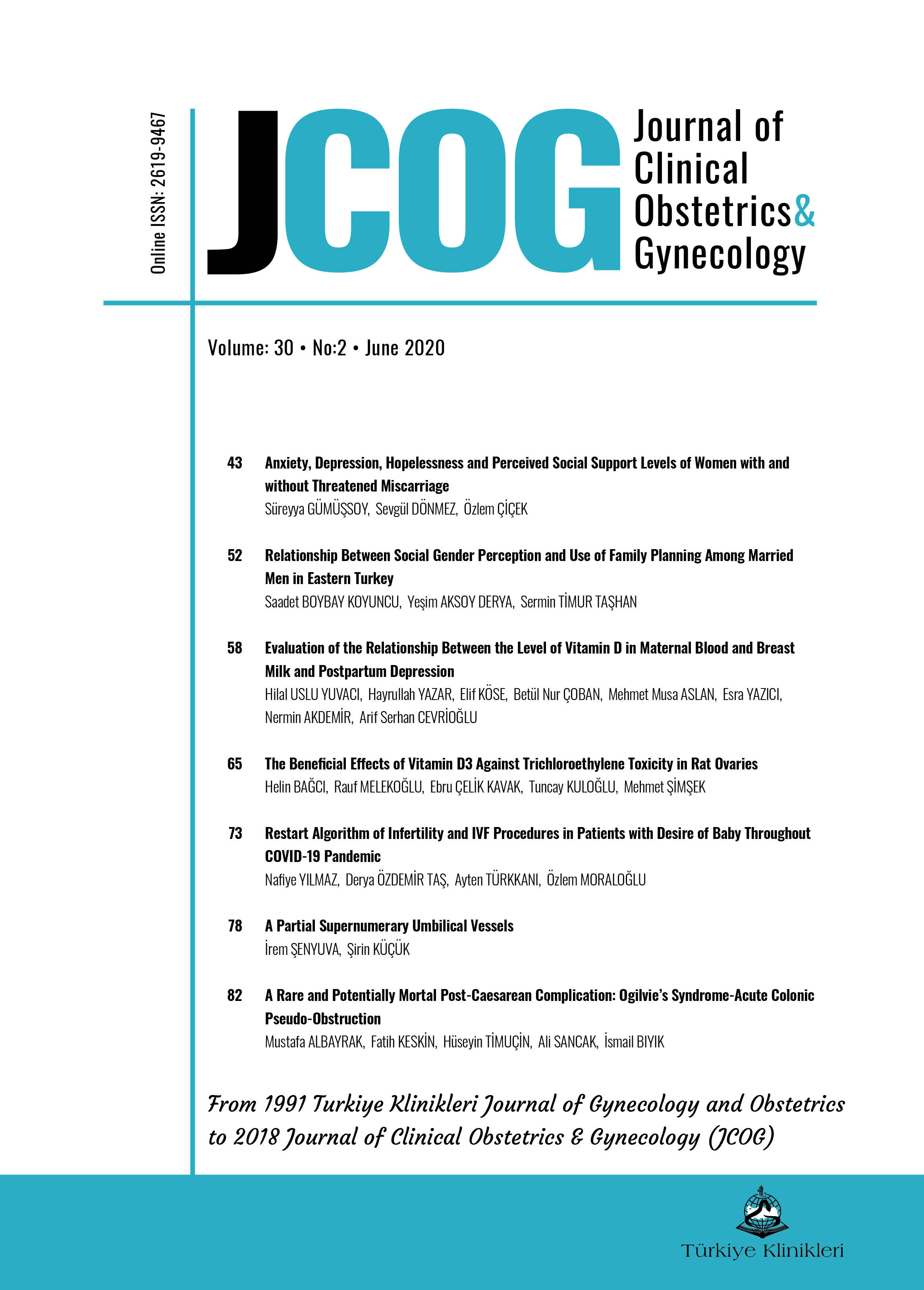Open Access
Peer Reviewed
CASE REPORTS
2469 Viewed1163 Downloaded
A Rare and Potentially Mortal Post-Caesarean Complication: Ogilvie's Syndrome-Acute Colonic Pseudo-Obstruction
Received: 08 Apr 2020 | Received in revised form: 15 Jun 2020
Accepted: 13 Jul 2020 | Available online: 11 Aug 2020
J Clin Obstet Gynecol. 2020;30(2):82-4
DOI: 10.5336/jcog.2020-75394
Article Language: EN
Article Language: EN
Copyright Ⓒ 2025 by Türkiye Klinikleri. This is an open access article under the CC BY-NC-ND license (http://creativecommons.org/licenses/by-nc-nd/4.0/)
ABSTRACT
Ogilvie's syndrome (acute colonic pseudo-obstruction) is acute massive functional dilatation of bowel without a distal mechanical obstruction. It is a rare, relatively unknown but potentially lethal entity because of its propensity for caecal perforation. Although commonly a disease of elderly with underlying co-morbidities especially following surgical interventions, caesarean section is the most common predisposing factor in obstetric age group. Diagnosis depends on the gross dilatation of caecum and ascending colon and exclusion of distal mechanical obstruction. Failure to respond to conventional measures necessities decompression of colon with colonoscopy and/or tube caecostomy in patients without perforation. Any sign of perforation mandates surgical intervention in which mortality is reported to be around 40%. Increased awareness and early diagnosis are at paramount importance to prevent bowel perforation.
Ogilvie's syndrome (acute colonic pseudo-obstruction) is acute massive functional dilatation of bowel without a distal mechanical obstruction. It is a rare, relatively unknown but potentially lethal entity because of its propensity for caecal perforation. Although commonly a disease of elderly with underlying co-morbidities especially following surgical interventions, caesarean section is the most common predisposing factor in obstetric age group. Diagnosis depends on the gross dilatation of caecum and ascending colon and exclusion of distal mechanical obstruction. Failure to respond to conventional measures necessities decompression of colon with colonoscopy and/or tube caecostomy in patients without perforation. Any sign of perforation mandates surgical intervention in which mortality is reported to be around 40%. Increased awareness and early diagnosis are at paramount importance to prevent bowel perforation.
REFERENCES:
- Reeves M, Frizelle F, Wakeman C, Parker C. Acute colonic pseudo-obstruction in pregnancy. ANZ J Surg. 2015;85(10):728-33. [Crossref] [PubMed]
- Bozin M, Khomko N, Shedda S. Recurrence of acute colonic pseudo-obstruction post-caesarean section: a case report. ANZ J Surg. 2014;84(3):196-7. [Crossref] [PubMed]
- Vanek VW, Al-Salti M. Acute pseudo-obstruction of the colon (Ogilvie's syndrome). An analysis of 400 cases. Dis Col Rectum. 1986;29(3):203-10. [Crossref] [PubMed]
- Elsebay L, Galal MA. Ogilvie's syndrome after cesarean section: case report in Saudi Arabia and Management Approach. Case Rep Obstet Gynecol. 2017;2017:5328160. [Crossref] [PubMed] [PMC]
- Jayaram P, Mohan M, Lindow S, Konje J. Postpartum acute colonic pseudo-obstruction (Ogilvie's syndrome): a systematic review of case reports and case series. Eur J Obstet Gynecol Reprod Biol. 2017;214:145‐9. [Crossref] [PubMed]
- Latunde-Dada AO, Alleemudder DI, Webster DP. Ogilvie's syndrome following caesarean section. BMJ Case Rep. 2013;2013: bcr2013010013. [Crossref] [PubMed] [PMC]
- Sariego J, Matsumoto T, Kerstein MD. Colonoscopically guided tube decompression in Ogilvie's syndrome. Dis Colon Rectum. 1991;34(8):720-2. [Crossref] [PubMed]
MENU
POPULAR ARTICLES
MOST DOWNLOADED ARTICLES





This journal is licensed under a Creative Commons Attribution-NonCommercial-NoDerivatives 4.0 International License.










